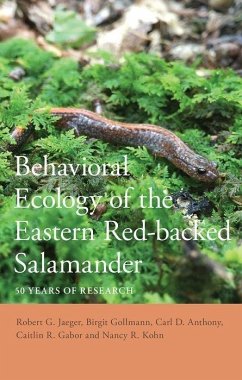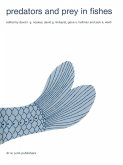Robert G Jaeger, Birgit Gollmann, Carl D Anthony
Behavioral Ecology of the Eastern Red-Backed Salamander
50 Years of Research
Robert G Jaeger, Birgit Gollmann, Carl D Anthony
Behavioral Ecology of the Eastern Red-Backed Salamander
50 Years of Research
- Gebundenes Buch
- Merkliste
- Auf die Merkliste
- Bewerten Bewerten
- Teilen
- Produkt teilen
- Produkterinnerung
- Produkterinnerung
Examines over fifty years of research of the red-backed salamander.
Andere Kunden interessierten sich auch für
![The Last Refuge of the Mt. Graham Red Squirrel The Last Refuge of the Mt. Graham Red Squirrel]() H Reed SandersonThe Last Refuge of the Mt. Graham Red Squirrel104,99 €
H Reed SandersonThe Last Refuge of the Mt. Graham Red Squirrel104,99 €![Ecology and Decline of Red Spruce in the Eastern United States Ecology and Decline of Red Spruce in the Eastern United States]() Ecology and Decline of Red Spruce in the Eastern United States159,99 €
Ecology and Decline of Red Spruce in the Eastern United States159,99 €![Sea Turtles of the Eastern Pacific Sea Turtles of the Eastern Pacific]() Sea Turtles of the Eastern Pacific89,99 €
Sea Turtles of the Eastern Pacific89,99 €![Ecology and Decline of Red Spruce in the Eastern United States Ecology and Decline of Red Spruce in the Eastern United States]() Ecology and Decline of Red Spruce in the Eastern United States83,99 €
Ecology and Decline of Red Spruce in the Eastern United States83,99 €![Tropical Conservation Tropical Conservation]() Tropical Conservation239,99 €
Tropical Conservation239,99 €![Population Production and Regulation in the Sea Population Production and Regulation in the Sea]() David CushingPopulation Production and Regulation in the Sea160,99 €
David CushingPopulation Production and Regulation in the Sea160,99 €![Predators and Prey in Fishes Predators and Prey in Fishes]() David L.G. Noakes / David G. Lindquist / G.S. Helfman / J.A. Ward (eds.)Predators and Prey in Fishes159,99 €
David L.G. Noakes / David G. Lindquist / G.S. Helfman / J.A. Ward (eds.)Predators and Prey in Fishes159,99 €-
Examines over fifty years of research of the red-backed salamander.
Hinweis: Dieser Artikel kann nur an eine deutsche Lieferadresse ausgeliefert werden.
Hinweis: Dieser Artikel kann nur an eine deutsche Lieferadresse ausgeliefert werden.
Produktdetails
- Produktdetails
- Verlag: Hurst & Co.
- Seitenzahl: 248
- Erscheinungstermin: 1. September 2016
- Englisch
- Abmessung: 236mm x 157mm x 18mm
- Gewicht: 522g
- ISBN-13: 9780190605506
- ISBN-10: 0190605502
- Artikelnr.: 47866276
- Herstellerkennzeichnung
- Libri GmbH
- Europaallee 1
- 36244 Bad Hersfeld
- gpsr@libri.de
- Verlag: Hurst & Co.
- Seitenzahl: 248
- Erscheinungstermin: 1. September 2016
- Englisch
- Abmessung: 236mm x 157mm x 18mm
- Gewicht: 522g
- ISBN-13: 9780190605506
- ISBN-10: 0190605502
- Artikelnr.: 47866276
- Herstellerkennzeichnung
- Libri GmbH
- Europaallee 1
- 36244 Bad Hersfeld
- gpsr@libri.de
Robert G. Jager is a retired former Professor of Biology at the Unviersity of Lousiana at Lafayette. He has spent the last forty years working on territoriality and interspecific competition in the red-backed salamanders, Plethodon cinereus. He is currently retired but continues to publish actively. Current research examines social behavior and, in particular, social monogamy/polygamy in red-backed salamanders. Birgit Gollmann is a Researcher at the Institut fur Zoologie at the Universitat Wien in Vienna, Austria. Caitlin Gabor is a Professor of Biology at Texas State University. Nancy Kohn is an adjunct faculty member in the department of Biology at the College of New Jersey. Carl D. Anthony is a Professor in the Biology Department at John Carroll University.
* 1. Prelude
* 1.1 Bob Jaeger meets the eastern red-backed salamander, Plethodon
cinereus
* 1.2 An introduction to red-backed salamanders
* 1.3 The plot of our research program
* 1.4 Comments concerning methodology and statistical paradigms
* 2. Interspecific competition between Plethodon cinereus and P.
shenandoah
* 2.1 Ecological studies
* 2.2 Behavioral experiments
* 2.3 Selected, recent research by others: interspecific competition
* 3. Intraspecific territoriality by P. cinereus
* 3.1 Definition and theory
* 3.2 Distribution and prey availability
* 3.3 Site tenacity by P. cinereus
* 3.4 Determining sex and defining behavioral patterns
* 3.5 The use of odors and dear enemy recognition
* 3.6 The expulsion of intruders
* 3.7 Testing territoriality in the forest
* 3.8 Numerous variables that affect territorial contests
* 3.9 Life history traits and territorial contests
* 3.10 Seasonal and geographic variation in territorial agonistic
behavior
* 3.11 Selected, recent research by others: intraspecific
territoriality
* 4. Foraging tactics by P. cinereus within territories
* 4.1. Foraging on live versus dead prey
* 4.2. Diet breadth
* 4.3. Optimal prey choice
* 4.4. Territorial and foraging behavioral conflicts
* 4.5. Assessing prey densities
* 4.6. Judging prey profitabilities
* 4.7. Conflicts between foraging behavior and territorial defense
* 4.8. Diet diversity and clutch size
* 4.9. Selected, recent research by others: foraging tactics
* 5. Pheromonal glands and pheromonal communication by P. cinereus
* 5.1. Early studies suggested that pheromones do occur
* 5.2. Do males of P. cinereus produce territorial pheromones?
* 5.3. Do females of P. cinereus produce territorial pheromones?
* 5.4. Where are those pheromones produced in males and females?
* 5.5. Focusing on the postcloacal gland
* 5.6. What information does the postcloacal gland communicate?
* 5.7. What signals do pheromones communicate?
* 5.8. Scent matching and tail autotomy
* 5.9. Do territorial pheromones aid in homing behavior by P. cinereus?
* 5.10. Are pheromones volatile?
* 5.11. More research needed
* 5.12. Selected, recent research by others: pheromonal communication
* 6. Interspecific territoriality and other interspecific behavioral
interactions
* 6.1. Interspecific territoriality between P. cinereus and P.
shenandoah
* 6.2. Rules of engagement with juveniles of P. glutinosus
* 6.3. Plethodon cinereus in an assemblage of salamanders
* 6.4. Ecological tests of behavioral predictions: enclosed plots on
the forest floor
* 6.5. More ecological tests of behavioral predictions: unenclosed
plots on the forest floor
* 6.6. Character displacement: P. cinereus versus P. hoffmani
* 6.7. Competition between P. cinereus and P. hubrichti
* 6.8. Diversity of behaviors by P. cinereus towards other species
* 6.9. Selected, recent research by others: interspecific
territoriality
* 7. Intraspecific social behavior within P. cinereus
* 7.1. Interactions of adults and juveniles in the forest and in the
laboratory
* 7.2. Distributions of adult males and females
* 7.3. Microdistributions of adults and juveniles
* 7.4. Female-female interactions
* 7.5. Male-female behavioral interactions in the forest
* 7.6. The ESS dating game
* 7.7. Males, females, and faeces
* 7.8. Females prefer larger males
* 7.9. Males and females prefer familiar opposite-sex individuals
* 7.10. Social monogamy
* 7.11. Mutual mate guarding
* 7.12. Sexual coercion
* 7.13. Imperfect information during sexual discrimination?
* 7.14. Relationship value and conflict resolution
* 7.15. Natural versus forced partnerships
* 7.16. Females are often genetically polyandrous
* 7.17. Switching from social monogamy to social polygamy
* 7.18. Brooding behavior and neonates: kin recognition?
* 7.19. What 3487 uniquely marked salamanders reveal about social
relationships
* 7.20. A preliminary view of social organization within P. cinereus
* 7.21. Selected, recent research by others: social behavior
* 8. Predator-prey interactions between P. cinereus and a snake
* 8.1. Can P. cinereus detect the snake visually or chemically?
* 8.2. Can the snake detect chemical cues from P. cinereus?
* 8.3. Naïve snakes recognize odors of P. cinereus
* 8.4. Tail autotomy deceives the snake
* 8.5. The snake follows the trail of P. cinereus
* 8.6. The predator-prey evolutionary arms race
* 8.7. Selected, recent research by others: predator-prey arms races
* 9. Cognitive ecology in P. cinereus
* 9.1. Numerical discrimination by P. cinereus
* 9.2. Both learning and heritability affect foraging ability
* 9.3. Displacement of territorial aggression
* 9.4. The impact of familiarity on salamander behavior
* 9.5. Individual recognition memory
* 9.6. Selected, recent research by others: cognitive ecology
* 10. Coda: synthesis and social behaviors by P. cinereus
* 10.1. Behavioral variation within a population
* 10.2. Behavioral options during contests
* 10.3. How salamanders choose among options
* 10.4. What are social, mating, and genetic monogamy?
* 10.5. Mea maxima culpa
* 1.1 Bob Jaeger meets the eastern red-backed salamander, Plethodon
cinereus
* 1.2 An introduction to red-backed salamanders
* 1.3 The plot of our research program
* 1.4 Comments concerning methodology and statistical paradigms
* 2. Interspecific competition between Plethodon cinereus and P.
shenandoah
* 2.1 Ecological studies
* 2.2 Behavioral experiments
* 2.3 Selected, recent research by others: interspecific competition
* 3. Intraspecific territoriality by P. cinereus
* 3.1 Definition and theory
* 3.2 Distribution and prey availability
* 3.3 Site tenacity by P. cinereus
* 3.4 Determining sex and defining behavioral patterns
* 3.5 The use of odors and dear enemy recognition
* 3.6 The expulsion of intruders
* 3.7 Testing territoriality in the forest
* 3.8 Numerous variables that affect territorial contests
* 3.9 Life history traits and territorial contests
* 3.10 Seasonal and geographic variation in territorial agonistic
behavior
* 3.11 Selected, recent research by others: intraspecific
territoriality
* 4. Foraging tactics by P. cinereus within territories
* 4.1. Foraging on live versus dead prey
* 4.2. Diet breadth
* 4.3. Optimal prey choice
* 4.4. Territorial and foraging behavioral conflicts
* 4.5. Assessing prey densities
* 4.6. Judging prey profitabilities
* 4.7. Conflicts between foraging behavior and territorial defense
* 4.8. Diet diversity and clutch size
* 4.9. Selected, recent research by others: foraging tactics
* 5. Pheromonal glands and pheromonal communication by P. cinereus
* 5.1. Early studies suggested that pheromones do occur
* 5.2. Do males of P. cinereus produce territorial pheromones?
* 5.3. Do females of P. cinereus produce territorial pheromones?
* 5.4. Where are those pheromones produced in males and females?
* 5.5. Focusing on the postcloacal gland
* 5.6. What information does the postcloacal gland communicate?
* 5.7. What signals do pheromones communicate?
* 5.8. Scent matching and tail autotomy
* 5.9. Do territorial pheromones aid in homing behavior by P. cinereus?
* 5.10. Are pheromones volatile?
* 5.11. More research needed
* 5.12. Selected, recent research by others: pheromonal communication
* 6. Interspecific territoriality and other interspecific behavioral
interactions
* 6.1. Interspecific territoriality between P. cinereus and P.
shenandoah
* 6.2. Rules of engagement with juveniles of P. glutinosus
* 6.3. Plethodon cinereus in an assemblage of salamanders
* 6.4. Ecological tests of behavioral predictions: enclosed plots on
the forest floor
* 6.5. More ecological tests of behavioral predictions: unenclosed
plots on the forest floor
* 6.6. Character displacement: P. cinereus versus P. hoffmani
* 6.7. Competition between P. cinereus and P. hubrichti
* 6.8. Diversity of behaviors by P. cinereus towards other species
* 6.9. Selected, recent research by others: interspecific
territoriality
* 7. Intraspecific social behavior within P. cinereus
* 7.1. Interactions of adults and juveniles in the forest and in the
laboratory
* 7.2. Distributions of adult males and females
* 7.3. Microdistributions of adults and juveniles
* 7.4. Female-female interactions
* 7.5. Male-female behavioral interactions in the forest
* 7.6. The ESS dating game
* 7.7. Males, females, and faeces
* 7.8. Females prefer larger males
* 7.9. Males and females prefer familiar opposite-sex individuals
* 7.10. Social monogamy
* 7.11. Mutual mate guarding
* 7.12. Sexual coercion
* 7.13. Imperfect information during sexual discrimination?
* 7.14. Relationship value and conflict resolution
* 7.15. Natural versus forced partnerships
* 7.16. Females are often genetically polyandrous
* 7.17. Switching from social monogamy to social polygamy
* 7.18. Brooding behavior and neonates: kin recognition?
* 7.19. What 3487 uniquely marked salamanders reveal about social
relationships
* 7.20. A preliminary view of social organization within P. cinereus
* 7.21. Selected, recent research by others: social behavior
* 8. Predator-prey interactions between P. cinereus and a snake
* 8.1. Can P. cinereus detect the snake visually or chemically?
* 8.2. Can the snake detect chemical cues from P. cinereus?
* 8.3. Naïve snakes recognize odors of P. cinereus
* 8.4. Tail autotomy deceives the snake
* 8.5. The snake follows the trail of P. cinereus
* 8.6. The predator-prey evolutionary arms race
* 8.7. Selected, recent research by others: predator-prey arms races
* 9. Cognitive ecology in P. cinereus
* 9.1. Numerical discrimination by P. cinereus
* 9.2. Both learning and heritability affect foraging ability
* 9.3. Displacement of territorial aggression
* 9.4. The impact of familiarity on salamander behavior
* 9.5. Individual recognition memory
* 9.6. Selected, recent research by others: cognitive ecology
* 10. Coda: synthesis and social behaviors by P. cinereus
* 10.1. Behavioral variation within a population
* 10.2. Behavioral options during contests
* 10.3. How salamanders choose among options
* 10.4. What are social, mating, and genetic monogamy?
* 10.5. Mea maxima culpa
* 1. Prelude
* 1.1 Bob Jaeger meets the eastern red-backed salamander, Plethodon
cinereus
* 1.2 An introduction to red-backed salamanders
* 1.3 The plot of our research program
* 1.4 Comments concerning methodology and statistical paradigms
* 2. Interspecific competition between Plethodon cinereus and P.
shenandoah
* 2.1 Ecological studies
* 2.2 Behavioral experiments
* 2.3 Selected, recent research by others: interspecific competition
* 3. Intraspecific territoriality by P. cinereus
* 3.1 Definition and theory
* 3.2 Distribution and prey availability
* 3.3 Site tenacity by P. cinereus
* 3.4 Determining sex and defining behavioral patterns
* 3.5 The use of odors and dear enemy recognition
* 3.6 The expulsion of intruders
* 3.7 Testing territoriality in the forest
* 3.8 Numerous variables that affect territorial contests
* 3.9 Life history traits and territorial contests
* 3.10 Seasonal and geographic variation in territorial agonistic
behavior
* 3.11 Selected, recent research by others: intraspecific
territoriality
* 4. Foraging tactics by P. cinereus within territories
* 4.1. Foraging on live versus dead prey
* 4.2. Diet breadth
* 4.3. Optimal prey choice
* 4.4. Territorial and foraging behavioral conflicts
* 4.5. Assessing prey densities
* 4.6. Judging prey profitabilities
* 4.7. Conflicts between foraging behavior and territorial defense
* 4.8. Diet diversity and clutch size
* 4.9. Selected, recent research by others: foraging tactics
* 5. Pheromonal glands and pheromonal communication by P. cinereus
* 5.1. Early studies suggested that pheromones do occur
* 5.2. Do males of P. cinereus produce territorial pheromones?
* 5.3. Do females of P. cinereus produce territorial pheromones?
* 5.4. Where are those pheromones produced in males and females?
* 5.5. Focusing on the postcloacal gland
* 5.6. What information does the postcloacal gland communicate?
* 5.7. What signals do pheromones communicate?
* 5.8. Scent matching and tail autotomy
* 5.9. Do territorial pheromones aid in homing behavior by P. cinereus?
* 5.10. Are pheromones volatile?
* 5.11. More research needed
* 5.12. Selected, recent research by others: pheromonal communication
* 6. Interspecific territoriality and other interspecific behavioral
interactions
* 6.1. Interspecific territoriality between P. cinereus and P.
shenandoah
* 6.2. Rules of engagement with juveniles of P. glutinosus
* 6.3. Plethodon cinereus in an assemblage of salamanders
* 6.4. Ecological tests of behavioral predictions: enclosed plots on
the forest floor
* 6.5. More ecological tests of behavioral predictions: unenclosed
plots on the forest floor
* 6.6. Character displacement: P. cinereus versus P. hoffmani
* 6.7. Competition between P. cinereus and P. hubrichti
* 6.8. Diversity of behaviors by P. cinereus towards other species
* 6.9. Selected, recent research by others: interspecific
territoriality
* 7. Intraspecific social behavior within P. cinereus
* 7.1. Interactions of adults and juveniles in the forest and in the
laboratory
* 7.2. Distributions of adult males and females
* 7.3. Microdistributions of adults and juveniles
* 7.4. Female-female interactions
* 7.5. Male-female behavioral interactions in the forest
* 7.6. The ESS dating game
* 7.7. Males, females, and faeces
* 7.8. Females prefer larger males
* 7.9. Males and females prefer familiar opposite-sex individuals
* 7.10. Social monogamy
* 7.11. Mutual mate guarding
* 7.12. Sexual coercion
* 7.13. Imperfect information during sexual discrimination?
* 7.14. Relationship value and conflict resolution
* 7.15. Natural versus forced partnerships
* 7.16. Females are often genetically polyandrous
* 7.17. Switching from social monogamy to social polygamy
* 7.18. Brooding behavior and neonates: kin recognition?
* 7.19. What 3487 uniquely marked salamanders reveal about social
relationships
* 7.20. A preliminary view of social organization within P. cinereus
* 7.21. Selected, recent research by others: social behavior
* 8. Predator-prey interactions between P. cinereus and a snake
* 8.1. Can P. cinereus detect the snake visually or chemically?
* 8.2. Can the snake detect chemical cues from P. cinereus?
* 8.3. Naïve snakes recognize odors of P. cinereus
* 8.4. Tail autotomy deceives the snake
* 8.5. The snake follows the trail of P. cinereus
* 8.6. The predator-prey evolutionary arms race
* 8.7. Selected, recent research by others: predator-prey arms races
* 9. Cognitive ecology in P. cinereus
* 9.1. Numerical discrimination by P. cinereus
* 9.2. Both learning and heritability affect foraging ability
* 9.3. Displacement of territorial aggression
* 9.4. The impact of familiarity on salamander behavior
* 9.5. Individual recognition memory
* 9.6. Selected, recent research by others: cognitive ecology
* 10. Coda: synthesis and social behaviors by P. cinereus
* 10.1. Behavioral variation within a population
* 10.2. Behavioral options during contests
* 10.3. How salamanders choose among options
* 10.4. What are social, mating, and genetic monogamy?
* 10.5. Mea maxima culpa
* 1.1 Bob Jaeger meets the eastern red-backed salamander, Plethodon
cinereus
* 1.2 An introduction to red-backed salamanders
* 1.3 The plot of our research program
* 1.4 Comments concerning methodology and statistical paradigms
* 2. Interspecific competition between Plethodon cinereus and P.
shenandoah
* 2.1 Ecological studies
* 2.2 Behavioral experiments
* 2.3 Selected, recent research by others: interspecific competition
* 3. Intraspecific territoriality by P. cinereus
* 3.1 Definition and theory
* 3.2 Distribution and prey availability
* 3.3 Site tenacity by P. cinereus
* 3.4 Determining sex and defining behavioral patterns
* 3.5 The use of odors and dear enemy recognition
* 3.6 The expulsion of intruders
* 3.7 Testing territoriality in the forest
* 3.8 Numerous variables that affect territorial contests
* 3.9 Life history traits and territorial contests
* 3.10 Seasonal and geographic variation in territorial agonistic
behavior
* 3.11 Selected, recent research by others: intraspecific
territoriality
* 4. Foraging tactics by P. cinereus within territories
* 4.1. Foraging on live versus dead prey
* 4.2. Diet breadth
* 4.3. Optimal prey choice
* 4.4. Territorial and foraging behavioral conflicts
* 4.5. Assessing prey densities
* 4.6. Judging prey profitabilities
* 4.7. Conflicts between foraging behavior and territorial defense
* 4.8. Diet diversity and clutch size
* 4.9. Selected, recent research by others: foraging tactics
* 5. Pheromonal glands and pheromonal communication by P. cinereus
* 5.1. Early studies suggested that pheromones do occur
* 5.2. Do males of P. cinereus produce territorial pheromones?
* 5.3. Do females of P. cinereus produce territorial pheromones?
* 5.4. Where are those pheromones produced in males and females?
* 5.5. Focusing on the postcloacal gland
* 5.6. What information does the postcloacal gland communicate?
* 5.7. What signals do pheromones communicate?
* 5.8. Scent matching and tail autotomy
* 5.9. Do territorial pheromones aid in homing behavior by P. cinereus?
* 5.10. Are pheromones volatile?
* 5.11. More research needed
* 5.12. Selected, recent research by others: pheromonal communication
* 6. Interspecific territoriality and other interspecific behavioral
interactions
* 6.1. Interspecific territoriality between P. cinereus and P.
shenandoah
* 6.2. Rules of engagement with juveniles of P. glutinosus
* 6.3. Plethodon cinereus in an assemblage of salamanders
* 6.4. Ecological tests of behavioral predictions: enclosed plots on
the forest floor
* 6.5. More ecological tests of behavioral predictions: unenclosed
plots on the forest floor
* 6.6. Character displacement: P. cinereus versus P. hoffmani
* 6.7. Competition between P. cinereus and P. hubrichti
* 6.8. Diversity of behaviors by P. cinereus towards other species
* 6.9. Selected, recent research by others: interspecific
territoriality
* 7. Intraspecific social behavior within P. cinereus
* 7.1. Interactions of adults and juveniles in the forest and in the
laboratory
* 7.2. Distributions of adult males and females
* 7.3. Microdistributions of adults and juveniles
* 7.4. Female-female interactions
* 7.5. Male-female behavioral interactions in the forest
* 7.6. The ESS dating game
* 7.7. Males, females, and faeces
* 7.8. Females prefer larger males
* 7.9. Males and females prefer familiar opposite-sex individuals
* 7.10. Social monogamy
* 7.11. Mutual mate guarding
* 7.12. Sexual coercion
* 7.13. Imperfect information during sexual discrimination?
* 7.14. Relationship value and conflict resolution
* 7.15. Natural versus forced partnerships
* 7.16. Females are often genetically polyandrous
* 7.17. Switching from social monogamy to social polygamy
* 7.18. Brooding behavior and neonates: kin recognition?
* 7.19. What 3487 uniquely marked salamanders reveal about social
relationships
* 7.20. A preliminary view of social organization within P. cinereus
* 7.21. Selected, recent research by others: social behavior
* 8. Predator-prey interactions between P. cinereus and a snake
* 8.1. Can P. cinereus detect the snake visually or chemically?
* 8.2. Can the snake detect chemical cues from P. cinereus?
* 8.3. Naïve snakes recognize odors of P. cinereus
* 8.4. Tail autotomy deceives the snake
* 8.5. The snake follows the trail of P. cinereus
* 8.6. The predator-prey evolutionary arms race
* 8.7. Selected, recent research by others: predator-prey arms races
* 9. Cognitive ecology in P. cinereus
* 9.1. Numerical discrimination by P. cinereus
* 9.2. Both learning and heritability affect foraging ability
* 9.3. Displacement of territorial aggression
* 9.4. The impact of familiarity on salamander behavior
* 9.5. Individual recognition memory
* 9.6. Selected, recent research by others: cognitive ecology
* 10. Coda: synthesis and social behaviors by P. cinereus
* 10.1. Behavioral variation within a population
* 10.2. Behavioral options during contests
* 10.3. How salamanders choose among options
* 10.4. What are social, mating, and genetic monogamy?
* 10.5. Mea maxima culpa








